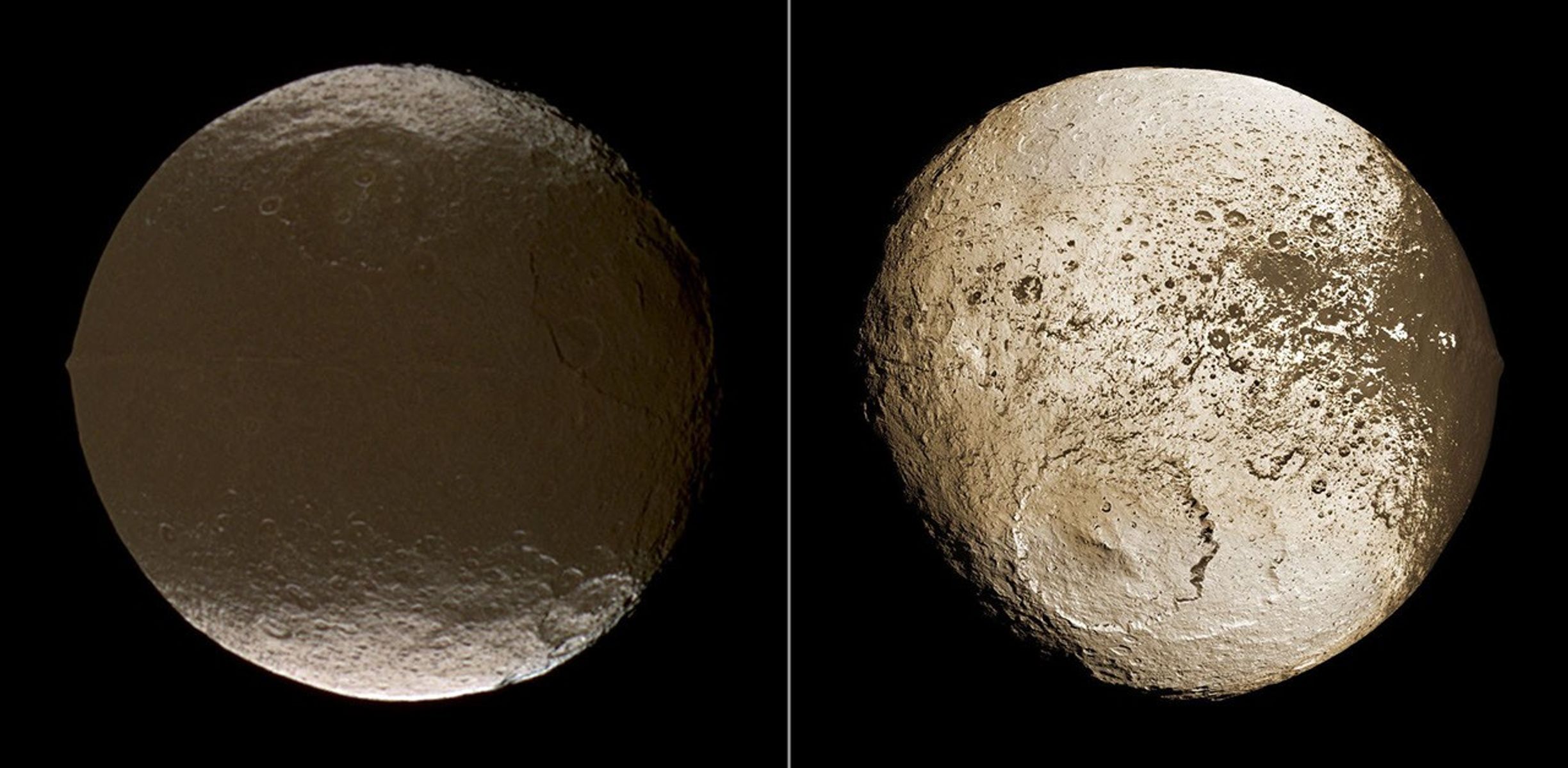Iapetus
Contents
Discovery
Giovanni Cassini discovered Iapetus on Oct. 25, 1671. However, to astronomers Iapetus appeared only as a dot whose brightness varied from brighter to fainter over the course of an orbit around Saturn. The Voyager I and Voyager II encounters in 1980 and 1981 validated Cassini's original observations and explanation with images showing the different reflectivity of Iapetus' hemispheres.
Overview
Iapetus has been called the yin and yang of the Saturn moons because its leading hemisphere has a reflectivity (or albedo) as dark as coal (albedo 0.03-0.05 with a slight reddish tinge) and its trailing hemisphere is much brighter at 0.5-0.6.
Saturn's third largest moon, Iapetus has a mean radius of 457 miles (736 kilometers) and a density only 1.2 times that of liquid water. It has been suggested that Iapetus (like Rhea) is three quarters ice and one quarter rock.
Iapetus orbits at 2,213,000 miles (3,561,000 kilometers) from Saturn. The great distance from Saturn's tidal forces and from most of the other moons and ring particles has probably allowed the Iapetus surface to be largely unaffected by any melting episodes that could have caused some smoothing or "resurfacing" as on some of the moons closer to Saturn.
However, despite the great distance, Saturn has tidally locked Iapetus. The moon always presents the same face toward Saturn. With its distant, inclined orbit, Iapetus is the only large moon from which there is a nice view of the rings of Saturn.
As with some other Saturnian moons, Iapetus is in resonance with Saturn's largest moon, Titan, which orbits at 759,200 miles (1,221,850 kilometers). That means that the two objects speed up and slow down as they pass each other in a complex set of variations. However, Iapetus has a diameter less than a third of Titan's diameter, so Titan's rotation and orbit are affected much less than those of Iapetus.
Giovanni Cassini observed the dark-light difference of this moon's surface when he discovered Iapetus in 1671. He noted that he could only see Iapetus on the west side of Saturn. He correctly concluded that Iapetus had one side much darker than the other side, and that Iapetus was tidally locked with Saturn.
Scientists have long wondered why one hemisphere of Iapetus is so dark in comparison to its other hemisphere, and in comparison to other surfaces in the Saturn system. Iapetus may be sweeping up particles from the more-distant dark moon, Phoebe. If that is the darkening mechanism, it should be steadily renewing the dark surface because very few fresh bright craters are detected within the dark terrain. An alternate theory is that there might be ice volcanism distributing darker material to the surface. Volcano-like eruptions of hydrocarbons might form the dark surfaces, particularly after chemical reactions caused by solar radiation.
The September 2007 Cassini flyby of Iapetus showed that a third process, thermal segregation, is probably the most responsible for Iapetus' dark hemisphere. Iapetus has a very slow rotation, longer than 79 days. Such a slow rotation means that the daily temperature cycle is very long, so long that the dark material can absorb heat from the sun and warm up. (The dark material absorbs more heat than the bright icy material.) This heating will cause any volatile, or icy, species within the dark material to sublime out, and retreat to colder regions on Iapetus. This sublimation of volatiles causes the dark material to become even darker -- and causes neighboring bright, cold regions to become even brighter. Iapetus may have experienced a (possibly small) influx of dark material from an external source, which could have warmed up and triggered this thermal segregation process.
The second most notable feature of Iapetus is its "equatorial ridge," a chain of 6-mile (10-km) high mountains girdling the moon's equator. On the anti-Saturnian side of Iapetus, the ridge appears to break up and distinct, partially bright mountains are observed. The Voyager I and Voyager II encounters provided the first knowledge of these mountains, and they are informally referred to as the Voyager Mountains.
There are two theories on how the ridge formed. Some scientists think the ridge was formed at an earlier time when Iapetus rotated much faster than it does today; others think the ridge is made of material left from the collapse of a ring.
How Iapetus Got its Name
John Herschel suggested that the moons of Saturn be associated with the mythical brothers and sisters of Kronus. (Kronus is the equivalent of the Roman god Saturn in Greek mythology.)
The name Iapetus comes from the Greek god (or Titan) Iapetus, who is a son of Uranus and Gaia, a brother to Kronus and the father of Atlas and Prometheus. As the father of Prometheus, the ancient Greeks regarded Iapetus as the father of the human race.
Cassini referred to Iapetus as one of the four Sidera Lodoicea (Stars of Louis) after King Louis XIV (the other three were Tethys, Dione and Rhea). Other astronomers called Iapetus by its number in the order of moons discovered at the time. Iapetus started as Saturn V, and it became Saturn VIII after additional moons were discovered. Geological features on Iapetus generally get their names from the French epic poem "The Song of Roland."































